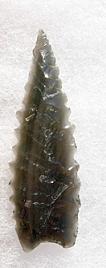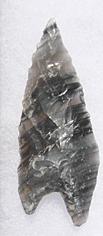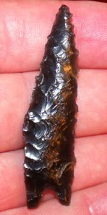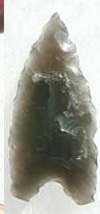Outline is Representative of Size and Shape:

Name Details:
Identified By: Robert F. Heizer and C. William Clewlow Jr.
Named For: Type Site Location
Date Identified: 1968
Type Site: Lovelock Lake Bed Site, Humboldt Sink, Nevada
Identified By: Robert F. Heizer and C. William Clewlow Jr.
Named For: Type Site Location
Date Identified: 1968
Type Site: Lovelock Lake Bed Site, Humboldt Sink, Nevada
Point Validity:
Valid type
Heizer was an eminent anthropologist and a professor at the University of California – Berkley. Heizer was influential in promoting our understanding of the archaeology of California and Nevada. Clewlow was a well-respected anthropologist from the University of California who conducted extensive excavations and surveys within the Great Basin. This type was named in a professional publication and has many professional references. This is considered a valid type.
Heizer was an eminent anthropologist and a professor at the University of California – Berkley. Heizer was influential in promoting our understanding of the archaeology of California and Nevada. Clewlow was a well-respected anthropologist from the University of California who conducted extensive excavations and surveys within the Great Basin. This type was named in a professional publication and has many professional references. This is considered a valid type.
Humboldt Basal Notch
Cluster: Humboldt Cluster Description of Physical Characteristics and Flaking Pattern:
This is a medium lanceolate point with an elliptical to flattened cross section. The blade ranges from excurvate to straight. The Basal Notch variation generally has larger ears and may have a straighter blade. The base may vary from concaved to notched. Basal thinning and grinding is usually seen on this point. The classic flaking pattern is oblique transverse, but also may have a random flaking pattern.
Size Measurements:
Total Length - 25 to 115 mm (average 35 to 45 mm), Max Blade Width - 14 to 40 mm, Basal Concavity - 3 to 5 mm, Thickness - 4 to 7 mm
Total Length - 25 to 115 mm (average 35 to 45 mm), Max Blade Width - 14 to 40 mm, Basal Concavity - 3 to 5 mm, Thickness - 4 to 7 mm
Commonly Utilized Material:
Additional Comments:
These points appear on the Colorado Plateau for a much shorter duration of time around 7,300 - 6,800 B.P. (Berry and Berry, 1986)
The Triple T variant (wider blade with a concaved base) appear to be the oldest of the Humboldt points (Thomas 1983).
It was thought that these points could be distinguished for the McKean point by the flaking pattern, The McKean flaking is primarily collateral style flaking and the Humboldt points have an oblique transverse style flaking. This may be some help, but the Humboldt flaking is not always oblique transverse, it may also have a random style flaking (Hattori, 1982).
It is thought that these points may have continued into the Fremont culture being used as knifes.
These points appear on the Colorado Plateau for a much shorter duration of time around 7,300 - 6,800 B.P. (Berry and Berry, 1986)
The Triple T variant (wider blade with a concaved base) appear to be the oldest of the Humboldt points (Thomas 1983).
It was thought that these points could be distinguished for the McKean point by the flaking pattern, The McKean flaking is primarily collateral style flaking and the Humboldt points have an oblique transverse style flaking. This may be some help, but the Humboldt flaking is not always oblique transverse, it may also have a random style flaking (Hattori, 1982).
It is thought that these points may have continued into the Fremont culture being used as knifes.
Distribution: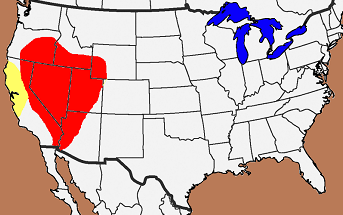

Distribution Comments:
This point is found through-out the Great Basin and into the Colorado Plateau (red). Humboldt type points extend into the coastal regions of California, but take on names like Mendocino Concave and Buchanan Eared (yellow)
This point is found through-out the Great Basin and into the Colorado Plateau (red). Humboldt type points extend into the coastal regions of California, but take on names like Mendocino Concave and Buchanan Eared (yellow)
Age / Periods:
Date: 7,000 - 3,000 B.P.
Cultural Period: Middle to Late Archaic
Glacial Period: Middle Holocene to Neoglacial
Culture:
Date: 7,000 - 3,000 B.P.
Cultural Period: Middle to Late Archaic
Glacial Period: Middle Holocene to Neoglacial
Culture:
Age Details:
Similar Points:
Allen, Bat Cave, Black Rock, Fourth of July Lanceolate, Green River, Mendocino Concaved, Meserve, Pinto Shoulderless, Plainview, Tulare Lake
Allen, Bat Cave, Black Rock, Fourth of July Lanceolate, Green River, Mendocino Concaved, Meserve, Pinto Shoulderless, Plainview, Tulare Lake
Other points in this cluster / Related / Associated Points:
Buchanan Eared, Humboldt Constricting Base, Humboldt, Humboldt Expanding Base, Mendocino Concave, Triple T
Buchanan Eared, Humboldt Constricting Base, Humboldt, Humboldt Expanding Base, Mendocino Concave, Triple T


